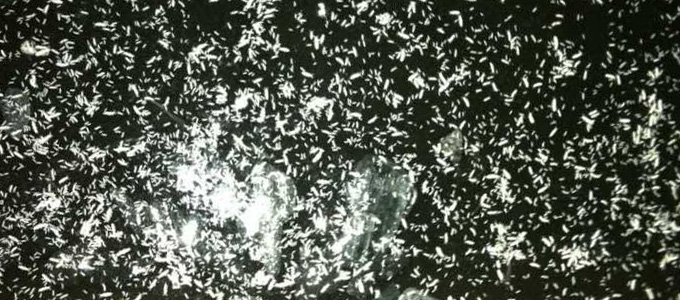
Temperate White Springtail Care Sheet
Temperate White Springtails (Collembolla sp.)
Temperate White Springtails Background
Temperate White Springtails (Collembolla Sp.) are a small white jumping hexapod that looks like a small insect. Temperate White Springtails reach about 3mm in length and are a janitorial species. Springtails are a janitorial species because they eat decaying matter found on earth. Springtails are found on almost all ground surfaces of the earth. Temperate White springtails enjoy a warm moist environment. Springtails reproduce sexually and then the females deposit eggs on their substrate. Reproduction occurs for them every other molt. Female Springtails will lay 90-150 eggs over a life time depending upon the species, and eggs take about a month to hatch depending upon temperatures. The Temperate White springtail reproduces the best numbers the fastest and most reliable. These Springtails reproduce best at temperatures of 65-85F, but can withstand temperatures extreme temperatures of high and low for short periods.
Why Temperate White Springtails?
Springtails are a great addition to a balanced diet for your frogs, fish, arachnids, and other live food needs. Springtails will not get too big for you small feeder needs because they never get over 4mm. They reproduce fast and are very easy to culture. Along with a food source springtails will help clean up your tank and keep molds down from left over pet food.
How to Culture Temperate White Springtails
There are several ways to culture Temperate White Springtails. You just have to be able to meet their environmental needs. The container we provided for you, which your springtails are in, is only a temporary home for shipping purposes.
Firstly, you will need a container to hold your springtails in. Plastic sweater totes work the best because they seal and keep the moisture in. But, you can use any plastic container that will keep a good seal. If you feel like putting some small holes in the containers you can do so. But, they should be very, very small to keep out pests like fungus gnats, which tend to like baker’s yeast, which is food for your springtails.
Now, you will need to prepare substrate for your springtails. There are several mediums that they can live in, and I will provide a couple mediums that can work for home culturing purposes.
- Peat Moss, coconut fiber or Potting soil with or without Horticulture Charcoal:
- Peat Moss: Take any type of peat moss and boil it on medium heat on the stove top in a large cooking pot for about an hour. This sterilizes it and we are going to change the Ph. Once peat moss has boiled for an hour remove it from the heat and let it cool to room temperature. Now, rinse your cooled peat moss under running water. Drain off all of water, except enough to leave it fairly damp. You will now need to add about 2 inches of your peat moss to your container. Now, add 1-3 cups of charcoal and mix it in if choosing to add coal.
- Coconut Fiber: Take your expandable coconut fiber and add enough water to it until it is fairly damp. Add about 2 inches of the coconut fiber to your container. Now, add 1-3 cups of charcoal and mix it in if choosing to add coal.
- Potting Soil: Take any good bagged potting soil and pour some into a microwave and oven safe bowl or dish. Now, either bake the soil at 350F in the oven for 20 minutes or nuke in the microwave for 2-3 minutes. Be very careful when taking out the soil because the container and the soil will be very hot! Let the soil cool to room temperature. Now, pour 2 inches or the potting soil into your plastic container. Now, add 1-3 cups of charcoal and mix it in if choosing to add coal.
- Pure Horticulture Charcoal: Add about 2-3 inches of pure horticulture charcoal, and add enough water to make it moist, but not soaking.
Don’t be hesitant. You can experiment with any combination of peat moss, coconut fiber, potting soil, and horticulture charcoal.
Now you will need to add your Springtails to your contain with the bedding medium. Take your culture you have received and add it directly in the middle of the container. No need to stir it in. Just give the plastic container a light shift or tap to settle the culture into the new bedding.
Food: Now we need to feed our culture to get it off to a good start. Springtails are cleaner crews feeding off of decaying matter. You can feed your springtails something as simple as uncooked rice’s, couscous, cooked pastas, fish flakes etc. Then you will want to sprinkle a good pinch of baker’s yeast over the surface. Feed your springtails every time you see their food is running out. If you feed too much, the grain will start to mold too much and foul your container.
Once you have all their requirements meet, you should be able to harvest them in about a month. To seed your pet’s habitat put them directly into the tank. To harvest your springtails place a plastic sheet on the surface wait for them to crawl on to the top and then dump them into the container. Or, use the float or blow method. Flood a corner of your springtails container and carefully drain only water and springtails into a bowl or dump the drain off into your pet’s habitat. To blow them into your pets container take the drain off or a spoon fool of soil and blow on them carefully and the springtails will jump and blow off into the area that you want. Remember don’t pick up any food or bedding because it will foul your fish tanks water.
When to Start a New Culture
You can expand your culture at any time after the culture establishes it’s self, usually after a month. This is based off of container size, food supply and temperatures. The bigger the container the longer it takes to establish a thriving culture. The less food you feed them after they eat it all gone the less the Springtails will reproduce. The colder the temperatures the less they will reproduce. All you have to do is repeat the processes above. Otherwise, wait until you can spoon out a good scoop of springtails. At this point, you need to get a container again, add bedding, food, and repeat the steps stated above. If you keep your culture going, you will have a never ending supply of springtails for your pets or fish.


